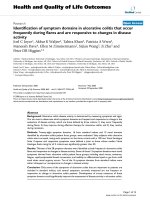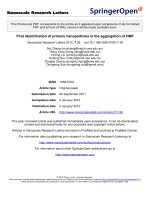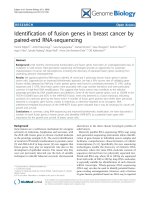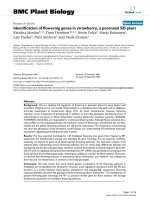Identification of physiologic race(S) of magnaporthe grisea (Herbert) barr causing blast disease of rice prevailing in different agro-climatic zones of Assam, India
Bạn đang xem bản rút gọn của tài liệu. Xem và tải ngay bản đầy đủ của tài liệu tại đây (153.82 KB, 5 trang )
Int.J.Curr.Microbiol.App.Sci (2018) 7(6): 3808-3812
International Journal of Current Microbiology and Applied Sciences
ISSN: 2319-7706 Volume 7 Number 06 (2018)
Journal homepage:
Original Research Article
/>
Identification of Physiologic Race(s) of Magnaporthe grisea (Herbert)
Barr Causing Blast Disease of Rice Prevailing in Different Agro-Climatic
Zones of Assam, India
K. D. Singha* and D. Hazarika
Regional Agricultural Research Station, Assam agricultural University,
Shillongani-782 002, India
*Corresponding author
ABSTRACT
Keywords
Blast, rice, Magnaporthe
grisea, physiologic race,
isolate
Article Info
Accepted:
25 May 2018
Available Online:
10 June 2018
Blast is one of the most destructive and wide spread disease of rice. It is caused by
Magnaporthe grisea (Herbert) Barr in different stages of its growth period. Of the
16 number of isolates collected from different locations of Assam, 6 physiologic
races viz., IB8, IB33, IC17, ID1, ID10 and IF1 are found prevailing in this region.
The isolate belongs to international race groups IB has not been detected so far in
India. Under the race group IB, two new races were identified IB8 and IB33.
Besides, in international race group ID and IF new race ID 10 and IF 1
respectively were also identified.
Introduction
Rice is the main staple food in India. It is
cultivated throughout India and more
particularly in Assam. But most of time its
production become limited due to attack by
many diseases. One of the most destructive
and wide spread fungal diseases of rice (Oryza
sativa L.) is blast caused by Magnaporthe
grisea (Herbert) Barr (anamorph Pyricularia
grisea Cav.) also affect other host grasses.
However, reports on the specific range of blast
fungus hosts are contradictory. This
discrepancy could be attributed to the
variation of genetic back-ground of the
fungus. The variation of genetic back ground
leads to variation in pathogenicity, increase
difficulties in developing resistant varieties
suitable for different agro climatic conditions.
Padmanabhan et al., (1970) also reported
existence of great variability of pathogenicity
among the Pyricularia oryzae isolates further
similar result was also reported by Ou (1985).
Padmanabhan et al., 1970, Veeraraghavan and
Premalatha Dath 1975, 1976 and 1977 were
reported existence of different physiologic
races of Magnaporthe grisea time to time. The
prevalence of physiologic race of P. oryzae
‘IE 3’ in Assam was reported by Roy (1987).
Considering the long gap of work in this
aspect particularly, to determine the number
and distribution of physiologic races of
3808
Int.J.Curr.Microbiol.App.Sci (2018) 7(6): 3808-3812
Magnaporthe grisea prevalent in different
agro-climatic zones of the state, a study was
conducted at Regional Agricultural Research
Station, Shillongani, Nagaon during 2014 &
2015 for identification of physiologic race of
Magnaporthe grisea and its prevalence in
Assam.
proposed by the United State –Japan Cooperative Blast project, have been used in
identification of physiologic race of
Pyricularia grisea along with IR 50 as
susceptible check. For this purpose, the
differential cultivars were grown in earthen
pot (12 cm in diameter) under isolated and
controlled condition.
Materials and Methods
All total 16 isolates have been collected from
5 (five) agro-climatic zones of Assam viz.,
Upper Brahmaputra Valley Zone (UBVZ),
Central Brahmaputra Valley Zone (CBVZ),
Lower Brahmaputra Valley Zone (LBVZ),
Barak Valley Zone (BVZ) and Hills zone. Of
the 16 isolates, 2 isolates from Jorhat district
of UBVZ, 2 isolates from Nagaon district of
CBVZ, 2 and 1 numbers of isolates from
Borpeta and Dhubri districts respectively of
LBVZ, 2 isolates from each district namely,
Cachar and Karimganj of BVZ and 5 isolates
from Karbi Anglong district of Hills Zone of
Assam.
Isolation was done from leaves and necks of
infected portion of plants collected from
different rice growing areas of Assam on oat
meal agar (OMA) with trace biotin and
thiamine (B & T). Purification of cultures had
been done by serial dilution technique and
hypha from single-spore colony transferred to
corn-meal-rice-straw agar medium and
incubated at 28+ 2 0C for 12-15 days for
sporulation (Sun et al., 1989). Spore
suspensions of inoculums were prepared from
12-15 days old culture with 1-2 x 105
conidia/ml. In case of weakly sporulating
isolates, the entire thallus was removed from
corn-meal-rice-straw agar medium and
homogenized with water in a Waring Blendor
for inoculation.
Eight international rice differential cultivars
viz., Raminad Str. 3, Zenith, NP-125, Usen,
Dular, Kanto-51, Sha-tiao-tsao (S) and Caloro
The earthen pots were filled with soil mixed
with urea and SSP left overnight before
sowing of seeds. The seedlings were again
refertilized at 15 days with 2% urea by foliar
spraying.
The seedlings (21 days old) were inoculated
with spore suspension of M. grisea at a conc.
of 1-2 x 105 conidia per ml along with 1%
carboxy methyl cellulose (CMC) as sticker
during the evening hours (Sun et al., 1989).
Inoculation with spore suspension of M.
grisea was carried out in late evening (15.00
hrs) in two sets one in the month ‘Sept-Oct’
and another ‘March-April’ for easy handling
of large number of isolates.
Disease scoring was done a week after
inoculation (Ahn et al., 1988) and differential
cultivars were refertilized by spraying 2% urea
and final record of disease was done when the
susceptible check showing high susceptible
reactions and then physiologic race
classification was followed as per standard
method (Ling and Ou, 1969).
Results and Discussion
On the basis of disease reactions on eight
international differentials, 6 physiologic races
of M. grisea viz., IB8, IB33, IC17, ID1, ID10
and IF1 were identified (Table 1). These
physiologic races were belongs to the
international race groups IB, IC, ID and IF.
The international race group IB has not been
reported so far in India.
3809
Int.J.Curr.Microbiol.App.Sci (2018) 7(6): 3808-3812
Table.1 Reactions of rice differential cultivars to isolates of Magnaporthe grisea and race identification
Name of
districts
Reminad
Str.3
Zenith
NP-125
Usen
Dular
Kanto-51
Sha-tiaotsao(S)
Caloro
Internation
al race
group
Jorhat
R*
S+
R
S
S
S
S
S
IB
33
Nagaon
R
R
R
S
S
S
S
S
ID
1
Borpeta
R
R
R
S
R
S
S
S
ID
10
Dhubri
R
R
R
R
R
S
S
S
IF
1
Cachar
R
R
S
R
S
S
S
S
IC
17
Karimganj
R
R
S
R
S
S
S
S
IC
17
R
S
S
S
R
R
R
R
IB
8
Karbi Anglong
*
Reactions on international rice differential cultivars
+
R= Resistant; S= Susceptible
Table.2 Geographical distribution of race Magnaporthe grisea in Assam
Agro-climatic zones of Assam
International race group and races
IB
IC
ID
IF
Upper Brahmaputra Valley
33
-
-
-
Central Brahmaputra Valley
-
-
1
-
Lower Brahmaputra Valley
-
-
10
1
Barak Valley
-
17
-
-
Hill zone
8
-
-
-
3810
Internation
al race
designation
Int.J.Curr.Microbiol.App.Sci (2018) 7(6): 3808-3812
In the present investigation, out of 6
physiologic races; 2 have already been
reported from Assam i.e., IC 17 and ID 1 by
different workers time to time (Padmanabhan
et al., 1970, Veeraraghavan and Premalatha
Dath 1975, 1976 and 1977) and 4 physiologic
races namely, IB 8, IB 33, ID 10 and IF 1
were detected for first time in Assam. The
number of isolates falling in race group IB,
IC, ID and IF were 7, 4, 4 and 1 respectively.
IB has also been detected for the first time
from India with two new physiologic races
IB8 and IB33.
Acknowledgement
The author is thankful to all persons for their
indispensible help during the period of
investigation.
References
The geographical distributions of identified
races are recorded IB 33 in UBVZ, ID1 in
CBVZ, ID10 and IF1in LBVZ, IC 17 in BVZ,
and IB 8 in Hills Zone. The race group IB was
detected in Hills zone as well as in UBVZ,
race group ID is recorded in two zones
namely, CBVZ and LBVZ, race group IF is
found in LBVZ and race group IC was
encountered from BVZ (Table 2).
Padmanabhan et al., (1970) reported four
physiologic races viz., IA6, ID1, IF3 and IJ1
from Assam. Thereafter, Veeraraghavan and
Premalatha Dath (1975, 1976 and 1977)
stated that the physiologic race IC 17 was also
prevalent in Assam during 1972 to 1975. Roy
(1987) reported prevalence of physiologic
race IE3 from Assam. Race groups viz., IA,
IC, ID, IE, IF and IJ had been reported time to
time by different workers. However, the race
groups viz., IA, IE and IJ were not
encountered in this study though reported by
different workers. Therefore, detection of the
race groups namely, IC, ID and IF simply
indicates their prevalence of the region for
long time. Detection of physiologic races
namely, IC17 and ID1 in this study, indicates
its wide distribution and stability in Assam.
The race group IF detected in this study has
already been reported by Padmanabhan et al.,
(1970) with race IF3. However, under the race
group ‘IF’ one new physiologic race i.e., IF1
has been identified. The race group IC, ID
and IF detection indicates the stable race
group of Assam. Besides, a new race group
Ahn, A.W., Yu, J.D. and Terres, C.G. (1988).
Classification of leaf blast (Bl) lesions.
Int. Rice Res. Newsl. 13(6):15-16.
Ling, K.C. and Ou, S.H. (1969).
Standardization of the international race
number
of
Pyriculari
oryzae.
Phytopathology 59: 339-349.
Ou, S. H. (1985). Rice Diseases
Commonwealth Mycological Institute,
125-145 pp.
Padmanabhan, S.Y., Chakrabarti, N.K.,
Mathur, S.C. and Veeraraghavan, J.
(1970). Identification of pathogenic
races of Pyricularia oryzae in India.
Phytopathology 60: 1574-1577.
Roy, A. K. (1987) Rice disease in Assam.
Indian Fmg. 37(3): 25.
Sun, G.C., Sun, S.Y. and Shen, Z.T. (1989)
Conditions for sporulation of rice blast
(Bl) fungus. Int. Rice Res. Newsl. 14(5):
12-13.
Veeraraghavan, J. and Dath, A. P. (1975)
Current position of physiologic race of
Pyricularia oryzae Cav. in India. Curr.
Sci. 44: 19-20.
Veeraraghavan, J. and Dath, A.P. (1976) Host
pathogen equilibrium between rice
(Oryza sativaI L.) and its pathogen
Pyricularia oryzae Cav. Curr. Sci. 45:
333-334.
Veeraraghavan, J. and Dath, A.P. (1977). The
present situation of physiologic races of
Pyricularia oryzae Cav. in India. Curr.
Sci. 46: 129-130.
3811
Int.J.Curr.Microbiol.App.Sci (2018) 7(6): 3808-3812
How to cite this article:
Singha K. D. and Hazarika D. 2018. Identification of Physiologic Race(s) of Magnaporthe
grisea (Herbert) Barr Causing Blast Disease of Rice Prevailing in Different Agro-Climatic
Zones of Assam. Int.J.Curr.Microbiol.App.Sci. 7(06): 3808-3812.
doi: />
3812









